Submachine gun R. Robinson Model 11 (Australia)
The development of the new design of the submachine gun, which received the symbol Model 11, was launched at the beginning of 1943. It took about a year to design a new weapon - a set of necessary drawings was prepared only in the spring of 1944. Delaying the work was associated with serious technical problems. R. Robinson was going to use some ideas of Gatenby, but to change them in accordance with his own plans. It took a lot of time to work out the updated automation, which is why the project was ready only for the spring 1944 of the year. In the future, the gunsmith had to refine the project in accordance with the wishes of the military, with the result that the first draft of the Model 11 project received preliminary approval only in the late autumn of the same year.
According to reports, having familiarized themselves with the project, representatives of the Australian army made new requirements for weapons relating to various aspects of its design and principle of operation. So, the Robinson submachine gun should not weigh more than 2,5 a pound (less than 1,4 kg), conduct automatic fire at a rate of up to 600 rounds per minute, have the highest possible magazine capacity and automatically throw away empty magazines. It took some time to solve these problems, which affected the overall pace of project development.
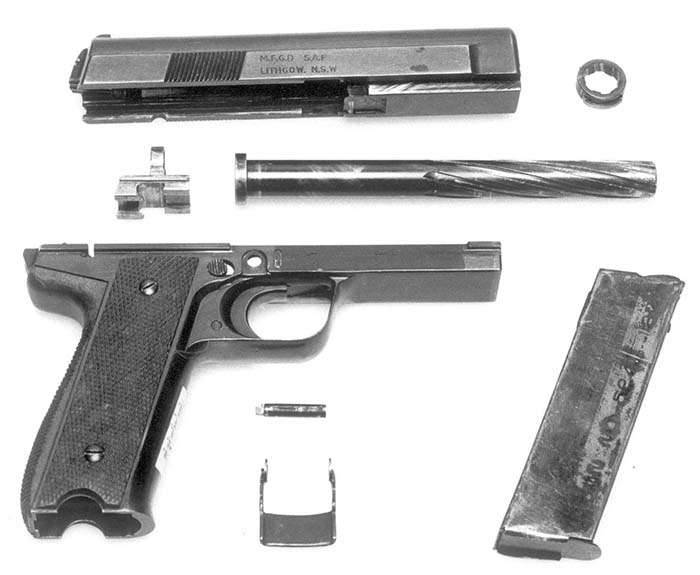
Partial disassembly of Model 11
In the original Gatenby Gun project, it was proposed to use a movable barrel, moved by the energy of the bullet and the recoil-fighting spring. Such a system had some advantages, but did not provide the required reliability of the supply of ammunition. For this reason, having undertaken two not very successful attempts at improvement, R. Robinson decided to fasten the barrel of the new weapon motionless and use a moving bolt with a large casing. Because of this and some other design features, the Model 11 submachine gun can also be categorized as an automatic pistol.
The main unit of the R. Robinson submachine gun was the L-shaped frame with a pistol grip, trigger guard, as well as fixtures for the movable casing of the bolt, parts of the firing mechanism, barrel, etc. From the point of view of design, this detail did not differ from similar assemblies of self-loading pistols of that time. On top of the frame should have been installed a movable casing of the shutter, just like the details of other weapons. In the future, the product Model 11 received some other additional units, which made it more similar to the usual submachine guns, as well as simplified operation.
The experience of testing and refining the submachine gun Gatenby showed that it was not the barrel that was supposed to move, but the bolt with the casing. For this reason, R. Robinson rigidly secured the barrel on the frame. In addition, for the correct operation of automation, several spiral grooves twisted clockwise (seen from the breech) appeared on the outer surface of the barrel. It was proposed to wear a special liner in the form of a washer with the corresponding protrusions on these grooves, which was movably mounted in front of the casing of the bolt.
The shutter along with the casing had to move along the frame back and forth, consistently producing the sending of the cartridge, the shot and the extraction of the sleeve. In this case, the weapon, despite the outward similarity of the main parts, in the combat and discharged positions was significantly different from the pistols of that time. In the discharged state of the weapon, the casing of the bolt was in the extreme forward position, because of which its front part completely closed the protruding barrel, and part of the frame above the handle remained open. In the cocked position, before the shot, the casing was located in the extreme rear position, “pistol-like”.

Frame without casing, bolt and barrel. View from above
Like its predecessor, the Model 11 machine gun was not supposed to be equipped with a relatively complex trigger mechanism. The used trigger ensured that the bolt was held in the rearmost position, and also made it possible to block the trigger and related parts or to fire in different modes. A curious feature of the USM was the fuse-translator flag. It was made in the form of a U-shaped part with a wide middle part and was placed inside the trigger guard. In the vertical position, the box blocked the mechanisms, and in addition, physically did not allow to pull the trigger. In the middle position, under 45 ° to the horizontal, the flag allowed firing single, and by pressing it to the frame in a horizontal position, it was possible to shoot bursts.
The supply of ammunition (according to some data, cartridge type 9x19 mm Para) was carried out from detachable box magazines with a single row of cartridges. The military demanded to create a store of the maximum possible capacity, as well as to ensure its automatic release after devastation, but, as far as we know, R. Robinson’s project did not reach this point.
It was proposed to aim the weapon at the target with the help of traditional “pistol” flies and a rear sight pillar placed on the casing of the bolt.
The custom design of automatics led to the appearance of the original principle of the mechanisms. The Model 11 submachine gun had to fire from an open bolt, for which it was necessary to place the bolt in the rearmost position before firing. At the same time, he closed the open back of the frame, and the muzzle of the barrel went beyond its limits. At the same time, the casing of the bolt caught on the sear trigger. When the trigger was pressed, the reciprocating spring, worn on the barrel, moved the bolt to the front position, simultaneously with which the cartridge was seized from the magazine with its subsequent displacement. In the extreme forward position, the bolt hit the primer with the help of a fixed drummer.
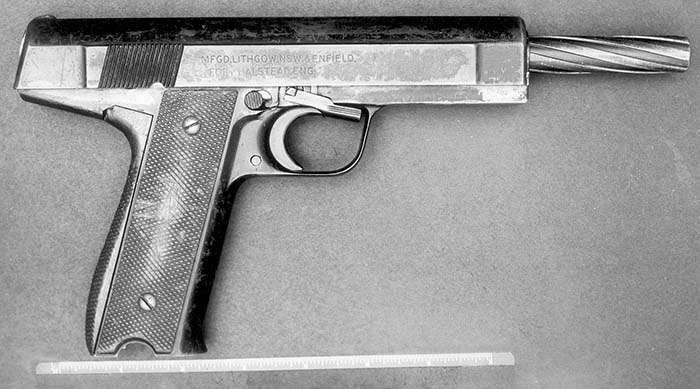
The weapon is ready to fire: the bolt is retracted and locked.
Under the influence of recoil energy, the bolt began to move backward, compressing the spring. In order to reduce the speed of movement of the bolt, R. Robinson provided the liner housing and grooves on the barrel. When the casing is rolled back, the protrusions of the liner should have been in contact with the grooves of the barrel, rotating the liner itself and slowing the movement of the bolt. With this, it was planned to reduce the speed of moving parts and thereby reduce the technical rate of fire to an acceptable level. Moving back, the bolt removed the cartridge case and threw it through the corresponding window of the casing. In the rearmost position, the bolt with the casing was again hooked on the sear (in single-shot mode) or immediately went ahead, producing a new shot.
The automation scheme proposed by Russell S. Robinson with the shutter moving before and after the shot had one noticeable plus. Massive shutter with a casing weighing 1 pound (initially they were lighter, but later calculations showed the need for increased mass) began to move forward even before the shot and the formation of an impulse from the powder gases. At the moment of the shot, they braked in the extreme forward position and pushed the weapon forward, thereby partially compensating for the recoil from the shot, directed backwards.
Such automatics made it possible to drastically reduce the removal of the barrel when firing bursts. The recoil impulse and push of the shutter partially compensated each other, allowing to fire with good indicators of accuracy and accuracy. However, later it turned out that this design led to a slight decrease in accuracy when shooting single. Moving forward before the shot, the bolt gave a small impetus to the rest of the "fixed" parts of the weapon, which led to some change in its position. As a result, with automatic firing, the submachine gun Model 11 showed higher accuracy characteristics than with single shots.
Due to the unusual design of the casing of the bolt and firing mechanism, the new submachine gun did not need a separate bolt delay. The store feeder had a special ledge that blocked the descent when cartridges were used up. Thus, regardless of the selected fire mode, after a shot using the last cartridge, the bolt was rolled back and locked in the extreme rear position. After this, the shooter could replace the magazine and continue shooting by simply pressing the trigger without any additional manipulations.
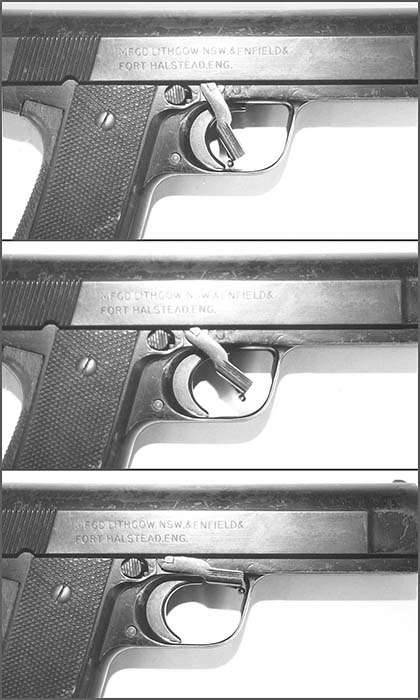
Different positions of the fuse-translator of fire. From top to bottom: USM lock, single fire, fire burst
The final draft of the Model 11 submachine gun was developed by the end of 1944. This allowed the assembly and testing of the experimental weapon to begin, but this work was delayed. At the beginning of 1945, R. Robinson was sent to Canada on official business, and then to the UK. During a Canadian business trip, a specialist had to discuss some issues with Small Arms Ltd. and John Inglis Co., Ltd. R. Robinson presented his representatives to his representatives. Canadian gunsmiths showed a certain interest, and also offered to improve the submachine gun, equipping it with the simplest shoulder rest of the telescopic structure. Attach this device was proposed on the back of the frame, above the pistol grip.
To enhance the usability of the new weapon, the original holster was also developed. It was a canvas bag of appropriate shapes and sizes with a top flap fastened with a button. The holster could be carried on a belt. An oblong pocket was provided on its outer surface for storing a spare magazine and a telescopic shoulder rest. The development of the original holster was needed because of the specific architecture of the weapon. In a discharged position, the shutter casing protruded beyond the frame, thereby increasing the overall length of the weapon.
After traveling to Canada and the UK, Russell S. Robinson returned to Australia, where he was able to continue working on his project. In 1945, he contacted the SAF Lithgow arms factory in Lithgow, where several experienced submachine guns were assembled. According to reports, the entire experimental batch consisted of only four new weapons. In addition, there is evidence of the manufacture of the fifth product, but this, apparently, was only a set of spare parts for the repair of prototypes. Currently it exists in the form of an assembled submachine gun and is the subject of controversy about its origin.
Only in 1946, did the Robinson Model 11 submachine guns reach the test. By this time, the designer was literally flooded with other work, because of which he later had to find time to continue improving the new submachine gun. As a result, the development of the project was seriously delayed and continued over the next few years.
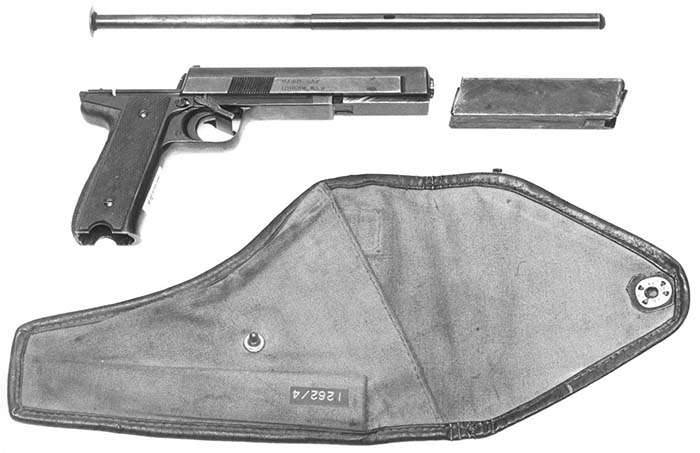
Set of submachine gun Model 11. Weapon itself, shoulder rest, additional magazine and holster. Weapon discharged, bolt in forward position
The purpose of the first stage of testing at one of the Australian polygons was to check the firing characteristics, as well as to assess survivability during the operation of weapons in difficult conditions. In parallel with the Model 11 submachine gun, weapons of a similar class Sten Mk V and MCEM were tested at the test site. This, in particular, made it possible to compare several new developments and identify their strengths and weaknesses in comparison with other samples.
Comparative tests of new weapons led to unexpected results. A new submachine gun designed by R. Robinson surpassed Sten Mk V and MCEM in terms of accuracy when firing automatic fire. At the same time, the Model 11 product gave way to competitors when comparing the accuracy of a single lamp. This weapon also showed unsatisfactory results when tested by pollution. Through the large rear window of the frame, which opens when the slide is moved forward, dirt and sand easily get inside the weapon, interfering with the work of mechanisms.
According to the test results, the Ordnance Board organization, which was responsible for checking prospective small arms, issued R. Robinson a new list of requirements for improving his weapons. Although the Model 11 product was positioned as a submachine gun, the military saw in it a specific version of the “classic” self-loading pistol with the possibility of firing bursts. Since this weapon looked like a pistol, had a pistol holster, held like a pistol and had an appropriate weight, the military demanded that the indicators of a single fire should be brought up to the level of existing self-loading pistols.
The draft of the updated automatic machine gun received the designation Model 16. To fulfill the requirements for the accuracy of a single fire, it was necessary to change the design of all weapons in a noticeable way. The relatively low accuracy of shooting single was associated with the movement of the bolt before the shot. Thus, when shooting in the self-loading mode, the shutter had to be fixed in the forward position and only after that initiate the shot. To solve this problem, it was necessary to remake the bolt, equipping it with a movable rather than a fixed drummer, change the trigger mechanism and modify the mass of other parts.
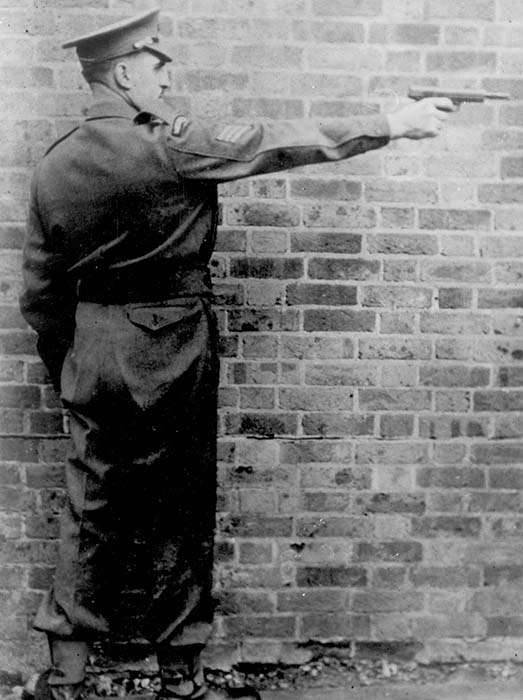
Shooting a Model Pistol 11
At that time, Russell S. Robinson received several important tasks related to other small arms, because of which he did not have enough time to develop his own projects. One result of this was stopping the Model 16 project to its full completion. The gunsmith managed to work out the concept of upgrading an existing submachine gun, but the prototype of the updated weapon was not made and was not tested.
A final attempt to perfect the Model 11 submachine gun was made in the 1948 year. R. Robinson intended to increase the mass of the bolt without the growth of the weight of all weapons, for which it was planned to use new materials. The experimental casing and bolt were made of a special material developed by General Electric and designated Heavy Alloy. With comparable strength characteristics, the new bolt turned out to be one and a half times heavier than the base. The casing of the new material had a smaller thickness and a greater length in comparison with the base. For the application of new parts, some changes were made to the frame design.
It is known that several new closures and housings were made of "heavy alloy". These parts could be used on existing prototypes, but there is no information about testing updated weapons. The use of new parts made it possible to increase certain characteristics of the weapon when firing in different modes, however, it was probably not tested in practice.
In the late forties, Russell S. Robinson retired from the Australian army. Shortly thereafter, he moved to the United States, where he continued to work on new small arms systems. Now he worked as an independent design engineer and was no longer dependent on other projects offered by the army or ordered by the military. Two decades after moving to the United States, R. Robinson applied for a patent. Having sent the necessary documents in 1970, in 73, the gunsmith received a document confirming his rights to the design of the Model 11 submachine gun.
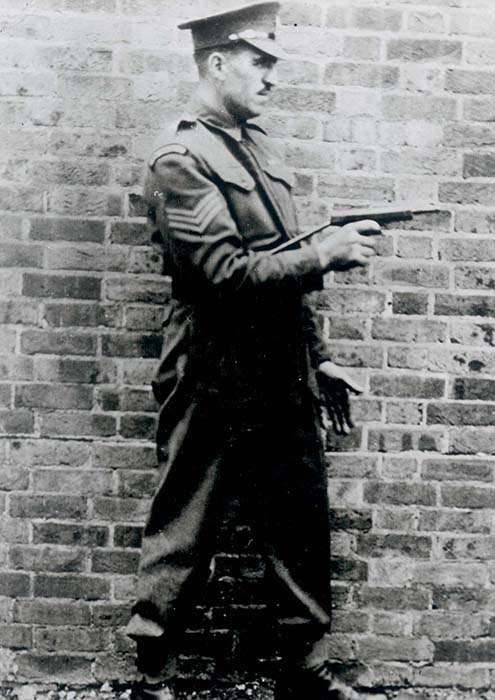
Shooting with an emphasis
One of the most interesting features of the Model 11 project is the difficulty with its classification. The overall appearance makes it possible to attribute this weapon to the category of automatic pistols, and the characteristics allow it to be considered a submachine gun. Currently, the issue of classification could be resolved without any problems. A few decades ago, the concept of PDW (Personal Defense Weapon) was proposed, to which the development of R. Robinson partially corresponds. His original weapon was relatively easy to handle, operate and carry, and also had sufficiently high characteristics and allowed the shooter to effectively defend against attack.
In the forties, when R. Robinson worked on his project, the concept of PDW did not exist yet, and the military had different views on promising small arms for the army. Submachine gun Model 11 did not fit into them, because of what there was a requirement to change the project. Perhaps, if this development appeared a few decades later, she would be able to interest the army or security forces. However, in the late forties, she failed to become a regular weapon for military personnel.
No more than five Robinson submachine guns that were used in the tests, as well as a number of experimental heavy bolts with casings were manufactured. According to some information, moving to the USA, R. Robinson took with him a part of these items. In the future, all prototypes went to museums and private collections.
On the materials of the sites:
http://smallarmsreview.com/
http://thefirearmblog.com/
http://world.guns.ru/
http://strangernn.livejournal.com/
- Ryabov Kirill
- Smallarmsreview.com, Thefirearmblog.com
Information